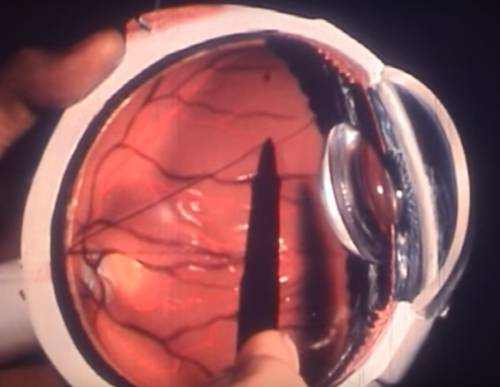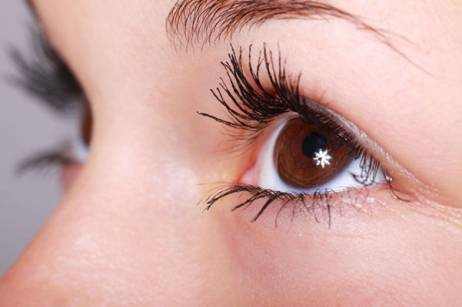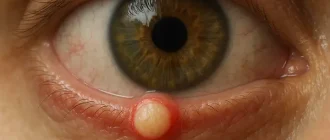Drooping eyelid, or ptosis, is a condition where the upper eyelid sags over the eye. It can range from mild, barely noticeable drooping to severe cases that interfere with vision.
Effectiveness of Treatment Methods for Ptosis
| Treatment Method | Effectiveness (%) |
|---|---|
| Eyeglasses with Crutches | 60% |
| Medications | 70% |
| Levator Resection Surgery | 90% |
| Frontalis Sling Surgery | 80% |
This chart highlights the effectiveness of various treatment methods for ptosis, with surgical options like levator resection showing the highest success rate at 90%, followed by medications and eyeglasses with crutches.
What Causes Drooping Eyelids?
Congenital Ptosis
Some individuals are born with ptosis due to underdeveloped levator muscles, the muscles responsible for lifting the eyelid. Congenital ptosis may affect one or both eyes. For example, a case reported in New York involved a six-year-old boy whose right eyelid drooped significantly, causing him to tilt his head back constantly. Surgery successfully corrected the condition, and his vision improved within weeks.
Acquired Ptosis
- Age-Related Changes: The most common cause of ptosis in adults is the weakening or stretching of the levator muscle due to aging. A 65-year-old woman from Chicago experienced severe drooping in her left eye, affecting her ability to read. Levator resection surgery restored her eyelid’s functionality and appearance.
- Neurological Disorders: Conditions such as Horner’s syndrome, myasthenia gravis, or third nerve palsy can lead to ptosis. For example, a 40-year-old man in Texas with myasthenia gravis reported fluctuating eyelid drooping, especially after physical activity. Medication significantly reduced his symptoms within a month.
- Trauma: Injury to the eyelid or surrounding muscles can also result in drooping. A construction worker in Florida suffered an eyelid injury from debris, leading to ptosis. Surgical repair not only corrected the drooping but also preserved his vision.
- Medical Conditions: Eye surgery, tumors, or chronic inflammation may trigger ptosis. For instance, a 55-year-old patient in California developed ptosis after cataract surgery. A specialized frontalis sling procedure corrected the issue, restoring both form and function.
Frequency of Ptosis Causes
| Cause | Frequency (%) |
|---|---|
| Age-Related Changes | 60% |
| Neurological Disorders | 20% |
| Trauma | 10% |
| Medical Conditions | 10% |
This chart illustrates the frequency of different causes of ptosis, highlighting that age-related changes are the most common cause, followed by neurological disorders, trauma, and medical conditions.
Expert Insight
Dr. Amanda Lopez, a board-certified ophthalmologist, emphasizes, “Understanding the underlying cause of ptosis is crucial for effective treatment. Whether congenital or acquired, early intervention often prevents complications such as amblyopia or chronic eye strain.”
Signs and Symptoms
- Drooping of one or both eyelids. For example, you might notice one eyelid covering part of your pupil, which can create a sleepy or tired appearance. In children, this can lead to frequent tilting of the head to see better.
- Reduced field of vision if the drooping is severe. Imagine struggling to see objects above or in front of you because the sagging eyelid obstructs your view. This is particularly noticeable when driving or reading.
- Fatigue or strain around the eyes. You may find yourself blinking more often or feeling an ache around your brow area as your muscles work harder to lift the drooping eyelid.
- Difficulty keeping the eye open or frequent raising of the eyebrows to compensate. This often results in a characteristic forehead wrinkling as you try to lift the eyelid for better visibility.
- Uneven appearance of the eyes. One eye may look noticeably smaller or lower than the other, causing asymmetry that can affect self-confidence or even social interactions.
Did You Know?
Ptosis can develop gradually over time or occur suddenly, requiring immediate medical evaluation to rule out serious conditions.
Diagnosis
An ophthalmologist or neurologist typically diagnoses ptosis through:
- Physical Examination: Observing eyelid movement, symmetry, and overall muscle responsiveness.
- Cost: $100-$200
- Accuracy: 8/10
- This method is quick and non-invasive, providing a baseline for further tests if required.
- Slit Lamp Exam: A detailed assessment of the eyelid, cornea, and surrounding muscles using magnified light.
- Cost: $150-$300
- Accuracy: 9/10
- The precision of this exam makes it ideal for detecting subtle abnormalities.
- Neurological Tests: Evaluating for associated conditions like myasthenia gravis, third nerve palsy, or Horner’s syndrome.
- Cost: $300-$800
- Accuracy: 9.5/10
- Often involves specialized tests like nerve conduction studies to pinpoint the cause.
- Imaging Studies: Advanced scans, such as MRI or CT, to visualize the brain, eye sockets, and muscles.
- Cost: $1,000-$3,000
- Accuracy: 10/10
- These studies are highly detailed and essential for ruling out tumors or other structural issues.
Each method complements the others, ensuring an accurate and comprehensive diagnosis tailored to the patient’s specific needs.
Treatment Options
Non-Surgical Approaches
- Eyeglasses with Crutches: Special frames designed to hold the eyelid up.
- Effectiveness: 6/10
- Cost: $100-$300
- Duration: Immediate support while wearing.
- Medications: In cases like myasthenia gravis, medications to improve muscle function may help.
- Effectiveness: 7/10
- Cost: $50-$200 per month
- Duration: Varies based on underlying condition.
Surgical Treatments
- Levator Resection: Tightening or shortening the levator muscle to lift the eyelid.
- Effectiveness: 9/10
- Cost: $2,000-$5,000
- Duration: Permanent correction.
- Frontalis Sling: Using a strap to connect the eyelid to the forehead muscle for better control.
- Effectiveness: 8/10
- Cost: $1,500-$4,000
- Duration: Permanent correction, may require adjustment over time.
- Eyelid Surgery for Tumors or Trauma: Correcting drooping caused by secondary conditions.
- Effectiveness: 8.5/10
- Cost: $3,000-$6,000
- Duration: Permanent correction, depends on complexity.
Recovery Time After Ptosis Treatments
| Treatment Method | Recovery Time |
|---|---|
| Eyeglasses with Crutches | Immediate (While Wearing) |
| Medications | 1-3 Months |
| Levator Resection Surgery | 2-4 Weeks |
| Frontalis Sling Surgery | 2-4 Weeks |
This chart provides an overview of recovery times for various ptosis treatments, ranging from immediate relief with eyeglasses to several weeks for surgical procedures.
Expert Tip
According to Reyus Mammadli, Health Care Advisor, “Surgical correction of ptosis is highly effective and can significantly improve both vision and appearance. Consult a board-certified ophthalmic surgeon for the best outcomes.”
Living with Ptosis
Practical Tips
- Regular Eye Checkups: Monitor vision changes and eyelid drooping.
- Use Sunglasses: Protect your eyes from excessive light and UV damage.
- Strengthen Eye Muscles: Simple exercises like looking up and down or practicing focus shifts may improve mild cases.
- Stay Alert for Symptoms: Watch for associated signs like double vision, which may indicate a neurological issue.
- Maintain Proper Hydration: Dehydration can affect muscle function and overall eye health.
- Prioritize Quality Sleep: Restful sleep supports muscle recovery and reduces strain on the eyes.
- Apply Cooling Compresses: To alleviate strain, use a cool compress around the eyes, especially after long periods of screen time.
- Limit Screen Time: Reduce eye fatigue by taking breaks every 20 minutes during digital work.
Editorial Advice
While ptosis may seem like a minor condition, it can impact daily life and self-confidence. Early diagnosis and treatment can prevent complications. Whether you opt for surgery or manage with non-invasive options, consult a qualified professional to tailor a solution that meets your needs. Addressing ptosis promptly can restore both function and quality of life.





